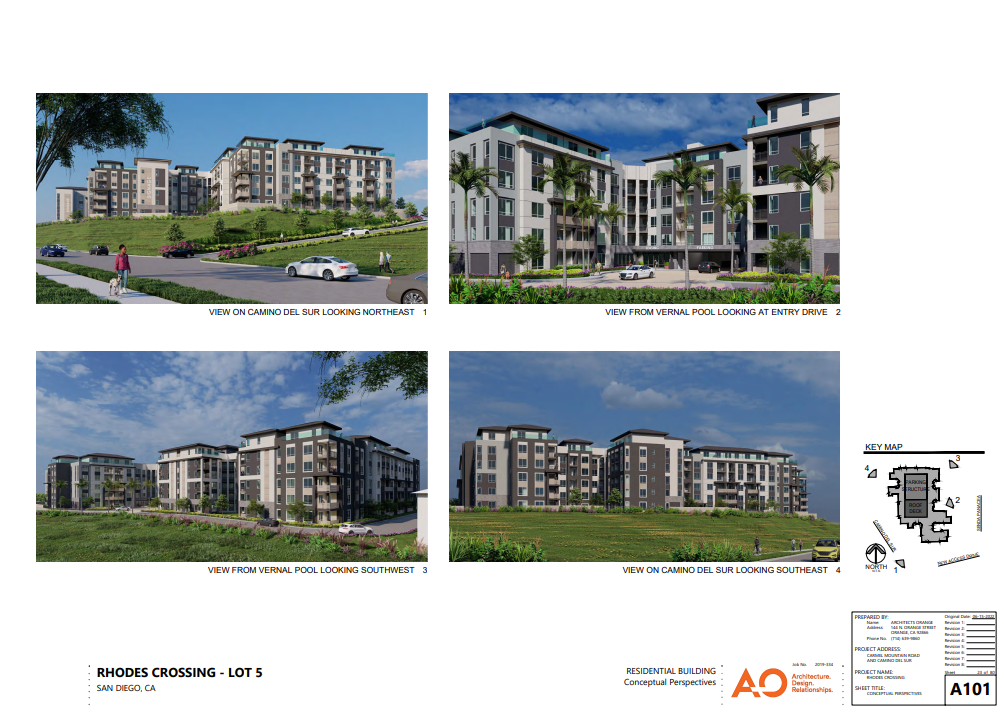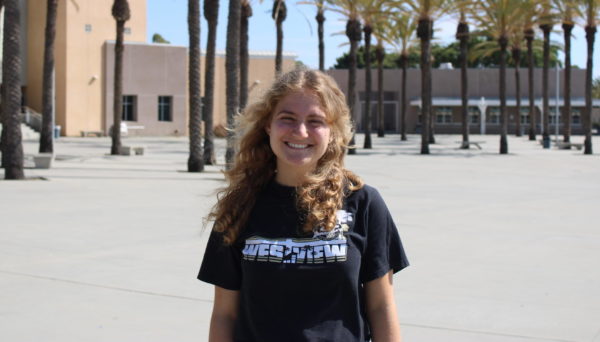When developer Keith Rhodes purchased three areas connecting Camino Del Sur and Carmel Mountain Road in 2004, his first proposal was for the land to be developed for “shopping center commercial and residential use,” according to Christensen Realty Group. Two pieces of this land have been sold to contractors who have built since then: the Arlo/Lennar single-family home neighborhood north of Carmel Mountain Road and the Holland project west of Camino Del Sur where an apartment complex is under construction.
The last remaining unsold land at Camino Del Sur and Carmel Mountain Road is split into four lots. Rhodes submitted a request to the City of San Diego Planning Department in June 2022 for a Community Plan Amendment, a Rezone, a Vesting Tentative Map, and a Site Development Plan for these lots. If these changes are approved, the plans for two of the four unsold lots west of Camino Del Sur will change from 52 single-family homes and a passive (not including official recreation) park to 511 multi-family units and no passive park.
Tara Lewis, the Supervising Public Information Officer at the City of San Diego’s Communications Department, said that the city and state have incentivized the development of denser housing in recent years in order to address a statewide and citywide housing crisis.
“Action is needed to provide more homes for current and future San Diegans,” Lewis said. “Over the last several decades, not enough homes and different types of homes have been built to meet the needs of the people living in the city of San Diego and the region. This has led to the high rents and unaffordable home prices we see today. Most people earning a middle income cannot afford to buy a home, and people earning less are struggling to make ends meet.”
Lewis said that proposed changes to Rhodes Crossing that change single family housing units to multifamily units have the potential to be a part of this larger shift toward a higher quantity of affordable housing in the community.
“Multifamily homes are generally less expensive than single-family homes, meaning this development will provide opportunities for people who previously could not afford to live in this neighborhood,” Lewis said.
The proposed Rhodes Crossing Amended plan is currently undergoing negotiations with community members, in particular the public forum known as the Rancho Penasquitos Community Planning Board.
The board’s chair, Brian Reschke, said that a priority that has arisen for many community members is to ensure that zoning types of new developments in the area remain at a reasonable zoning. Many members of the community hope to prevent an excessive increase in stories planned when the land is eventually sold to other developers and contractors. According to Reschke, the community’s concern is that what happened with the Cisterra commercial project west of Camino Del Sur, where the land was up-zoned to allow up to 13 stories to be built, could happen to other developments.
The new proposal for the apartment building adjacent to Senda Panacea would change the lot’s zoning, which would change the permitted maximum density of the building from one dwelling unit per each 600 square feet of lot area to one dwelling unit per each 400 square feet of lot area and change the height limit from 30 feet to an unlimited height maximum. The developer has proposed using this change to build seven stories.
“As a community, [many are] arguing that [they] would like to see the middle grade zoning that says there’s a height limit of four stories,” Reschke said. “[The community’s] fear is that once something [gets] approved, then the project could get sold and the next developer behind them could come in and say, ‘we’re going to apply for a higher density’ and the city could say ‘we don’t need to review it,’ and then we end up with more units than we planned.”
Mary Fox, chair of the Rancho Penasquitos Community Planning Group’s Land Use Committee, said that the largest concern is that the bulk, height, and scale of the proposed seven story apartment complex is not consistent with the existing community plan. The community is also concerned about the potential environmental impact of the building, which would be built on a lot with ecologically sensitive vernal pools. The building plan has also been criticized for eliminating a proposed park.
“The community feels that with the density that’s been added in this entire area, not just these but the Holland project and the Lennar Homes that are already there, that some open space should remain,” Fox said.
Shayna Mehta (11) lives on Senda Panacea. She said that the change in plans for the Rhodes lot concerns her due to its proposed impact on her home’s light source and the environmental impact of reducing undeveloped land.
“Knowing that now the last bit of open area that we have where we get most of our sunlight in the [day] is potentially going to be blocked off is frustrating to hear,” Mehta said. “We’re taking away so much natural land that we had left there and they’re not doing anything restorative.”
Senda Panacea resident Manisha Gupta said that she’s also concerned about the effects of the proposed building on her home’s aesthetic value and atmosphere.
“Seven stories on a higher grade is pretty high, which means that all the homes on the street are going to be devoid of sunlight,” Gupta said. “Some of the homes paid a bunch of money for the view that they were getting, and they are going to lose their privacy with homes on a higher grade looking down upon them.”
A summary of the development impacts of Rhodes Crossing from 92129 News cited an estimated 1,200 cars that would accompany the new residents of all the projects in Rhodes Crossing, including the proposed building near Senda Panacea. Gupta also said she’s concerned about how the influx of residents will affect traffic and safety in the neighborhood, which has already been changing since the development of other parts of Rhodes Crossing like Holland and Arlo/Lennar.
“We don’t know how they [will] manage the traffic with more vehicles in the area for which there is no available parking,” Gupta said. “I’ve already noticed parking spilling into our neighborhood from the existing community that has been built.”
PUSD Board of Education President Darshana Patel said that she’s concerned that the proposed building is not designed for families, whom PUSD would benefit from moving in and increasing enrollment. The proposed building would not be attractive to many families, she said, due to the proposed units being one- and two-bedroom units, which are often too small for families, and being market-rate, which is unaffordable for many middle- and low-income residents.
As a former member of the Rancho Penasquitos Community Planning Board, Patel said that previous developers have worked with the community to accommodate public concerns into development plans.
“I would love to see the developer work with the city and the community to build a project that everyone can be proud of,” Patel said.
Since negotiations over the remaining lots in Rhodes Crossing are not over, Reschke said that community members can seek out opportunities to have their voices heard if they have qualms about the new proposal and vote for officials with their concerns in mind.
“For people that want a shift in development, they’re going to need to have their voice heard and they’re going to need to come to the [community planning board] meetings where we discuss this project,” Reschke said. “We’re going to have multiple people up for election [in 2024] and it’s not just our [District 5] representative that is going to be the one that we need to influence.”



![Jolie Baylon (12), Stella Phelan (12), Danica Reed (11), and Julianne Diaz (11) [left to right] stunt with clinic participants at halftime, Sept. 5. Sixty elementary- and middle-schoolers performed.](https://wvnexus.org/wp-content/uploads/2025/09/IMG_1948-800x1200.png)
![Siddhi Bhavsar (10) [left] and Riddhi Bhavsar (10) [right] carry the NJROTC flag, Sept 13. The annual Poway Rotary Parade gave the unit the chance to represent Westview.](https://wvnexus.org/wp-content/uploads/2025/09/DSC00628-1200x900.jpg)
